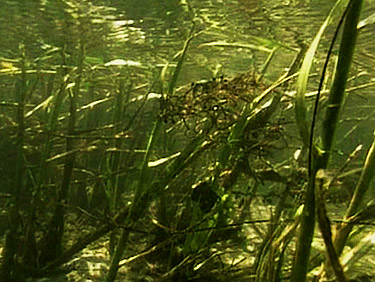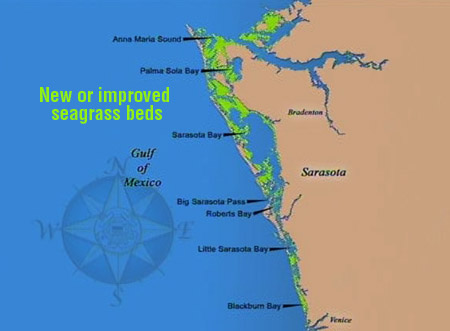 
Seagrasses provide shelter and protection essential to supporting much of the Bay’s marine life. It is generally recognized that seagrass coverage is a function of water clarity and availability of appropriate bottom substrate. The Bay area is home to five common species of seagrasses: shoal grass, turtle grass, manatee grass, widgeon grass and star grass.
Seagrass habitat decreased by 30 percent from 1950 to 1988 as a result of declines in water clarity and dredge-and-fill operations.
Aerial photography shows that seagrass beds have grown by more than 1,200
acres. This growth has created 5,500 acres of continuous, interconnected
seagrass which surpasses what aerial photos show existed in 1950.
Aerial photography shows that approximately 593 new acres of seagrasses have been mapped between 1988 and 2003. Continuous seagrass beds in Sarasota Bay have also increased by 3,465 acres; this equates to a total of 4,058 acres of new or improved seagrass beds in Sarasota Bay.
 The overall increase in new beds and the presence of more continuous beds suggests that water quality has improved in the Bay. Moreover, trends in seagrass regeneration vary among embayments, most likely due to differences in nearby water quality. The overall increase in new beds and the presence of more continuous beds suggests that water quality has improved in the Bay. Moreover, trends in seagrass regeneration vary among embayments, most likely due to differences in nearby water quality.
North Sarasota Bay has seen expansion in coverage as well as the lower bays. These positive trends are indicative of water-quality improvement throughout Sarasota Bay segments.
The Sarasota Bay Estuary Program is working with its partners to better understand the fluctuation in seagrass coverage throughout Sarasota Bay. The latest seagrass numbers suggest that Sarasota Bay seagrass levels were at 110 percent of 1950 in 2006.
Back To Top |